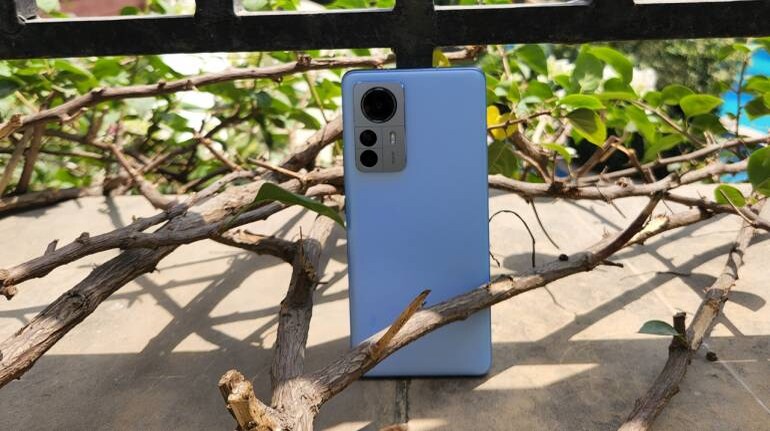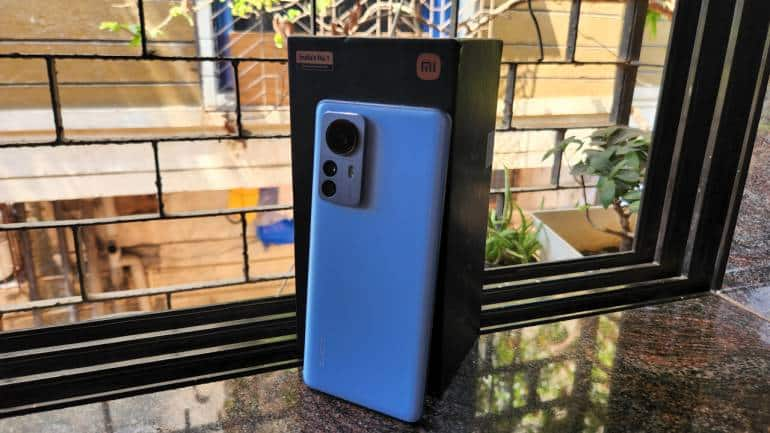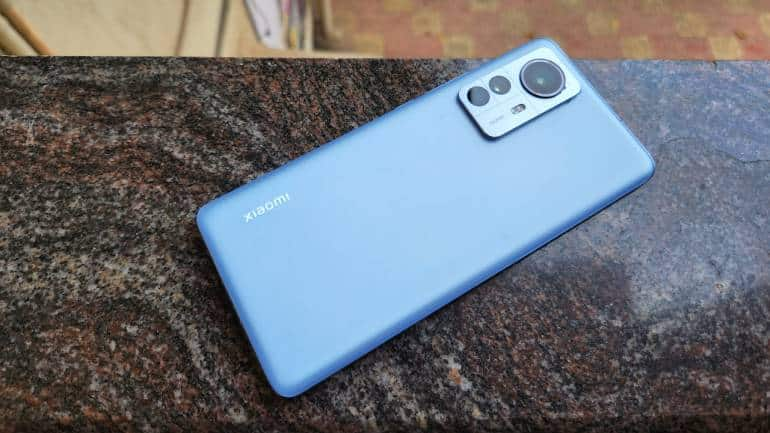



Last week, Xiaomi unveiled its first flagship smartphone of 2022 in India. And from the looks of the specs sheet, Xiaomi wasn’t holding back with the 12 Pro. There’s no doubt that the Xiaomi 12 Pro has all the makings of a premium smartphone. But before we take a brief look at the company’s latest flagship smartphone, it is worth noting that the Xiaomi 12 Pro doesn’t come cheap, with a starting price of Rs 62,999.
The Xiaomi 12 Pro may not be the sleekest smartphone on the block, but it does look good. One aspect unique to the 12 Pro is its unique metal camera deco, which protrudes quite a bit from the back panel and houses the phone’s rather neatly arranged camera modules. The rest of the back panel has a nice matte finish that is quite resistant to fingerprints, while the handset itself is available in Noir Black, Couture Blue, and Opera Mauve colour options.

Xiaomi also doesn’t comprise much in terms of build quality. The Xiaomi 12 Pro is protected by glass on the front and back, although the back uses an unnamed glass while the screen is secured by Gorilla Glass Victus. The 12 Pro also has a metal frame with all its buttons on the right and the SIM tray at the bottom. What the Xiaomi 12 Pro was missing was an IP68 rating, which is a must-have for a flagship smartphone. The Xiaomi 12 Pro also has speaker grilles on the top and bottom.
AudioThe speakers on the top and bottom are also unique to smartphones. The Xiaomi 12 Pro is a first of its kind ‘Quad Stereo Speaker Setup’. The setup is completed by two dedicated woofers and two dedicated tweeters. The audio is further amplified by its Dolby Atmos support.

The sound on the Xiaomi 12 Pro is tuned by Harmon Kardon and is Hi-Res Wired and Wireless Audio certified. While the quad speakers don’t produce the loudest audio on a smartphone, it does offer more balanced audio.
DisplayThe display on the Xiaomi 12 Pro is one of the best in its class with 15 awards from DisplayMate. The display itself uses a 6.73-inch QHD+ (2K+ Resolution) E5 AMOLED panel with an advertised peak brightness of 1500 nits, making it easily visible under direct sunlight. The 10-bit colour display has a 120Hz refresh rate and a 480Hz touch sampling rate, making it excellent for gaming. Additionally, the LTPO2 technology enables a variable refresh rate capable of scaling between 1Hz to 120Hz.

The screen also comes with AdaptiveSync Pro technology that helps switch the display to the exact refresh rate required for the task at hand. The panel also supports HDR10+, and Dolby Vision, and can register up to 10 fingers simultaneously. The screen also pumps out vibrant colours and sharp image quality. It also has excellent viewing angles. This is undoubtedly one of the best displays on a smartphone.
PerformanceFor performance, the Xiaomi 12 Pro opts for a Snapdragon 8 Gen 1 chipset paired with up to 12GB of LPDDR5 RAM. The phone also comes with 256GB of UFS 3.1 storage across both variants. The Xiaomi 12 Pro also has a large cooling system that is designed to keep the phone cool under pressure, and it handles this task pretty well. However, long gaming sessions will see the phone get pretty hot, despite the large cooling solution.

Genshin Impact, Call of Duty: Mobile, Asphalt 9: Legends, Darkness Rises, and Raid: Shadow Legends all ran smoothly without any hitches. We also saw the phone perform well in Geekbench, scoring 1301 points in the multi-core test and 3701 points in the multi-core test. In terms of performance, the Xiaomi 12 Pro doesn’t seem to be lacking, in fact, it exceeded expectations in everything I threw at it.
CameraPhotos and videos on the Xiaomi 12 Pro are handled by a triple-camera setup. This setup includes a 50 MP Sony IMX707 primary sensor with OIS, a 50 MP ultrawide lens with a 112-degree FoV, and a 50 MP telephoto unit with 2x optical zoom. On the front, the 12 Pro opts for a 32 MP selfie shooter with an f/2.5 aperture. So how do these cameras perform in real-world scenarios; the short answer is pretty dam good! But let’s flesh it out:

It is worth noting that the Xiaomi 12 Pro has one of the largest main camera sensors, bigger than that of the Galaxy S22 Ultra (Review). The large sensor results in some stunning imagery. The main camera captures photos with accurate colours with a bit of punch and vibrance. Colour tones are not always natural-looking, but that’s not such a bad thing as it can make photos pop. Additionally, there are no signs of excessive sharpening and dynamic range was always on point. There’s also a 50 MP mode to get more detail in a shot, although it wasn’t very different from the main camera.
I also found that the main camera dealt with images in complex lighting equally well. Night mode kicks in automatically in dimmer environments and the results are quite impressive. Images are on the darker side as the algorithm doesn’t dramatically brighten shadows, although colours tend to pop, while images didn’t appear too saturated. Night mode also handled noise extremely well and maintained good levels of detail in shots. And all of this is done in a matter of seconds.
While the 50 MP ultrawide does sound impressive on paper, Xiaomi uses a smaller Samsung JN1 sensor. There’s no crazy 150-degree focal length like we saw with the Realme GT 2 Pro (Review). However, the ultrawide maintains colour consistency with the main camera, while also pumping out sharp and crisp photos with good dynamic range and detail. I didn’t notice a lot of difference in the full 50 MP shots using the ultrawide shooter. There’s a noticeable drop in quality on the ultrawide at night, although results are respectable, and colours and sharpness are maintained across the two sensors.
Last but not least is the 50 MP telephoto camera, which uses the same sensor as the ultrawide camera. The unit offers 2x optical zoom, which is rather disappointing considering the crazy zoom numbers we’ve seen on devices like the Galaxy S22 Ultra and Mi 11 Ultra (Review). The results on the telephoto camera weren’t very difficult from that of the ultrawide unit. However, detail tends to drop off after 5x zoom, although the phone also remains quite stable at 20x zoom.
The camera also switches to the telephoto sensor when using Portrait mode, although I’d prefer the option of using it with the main camera as well. Selfies are handled with the 32 MP front camera, producing nice colours with good dynamic range. Edge detection was also on point when using the portrait mode on the front camera. The Xiaomi 12 Pro has a ton of modes, including a Long Exposure, Dual Video, VLOG, Supermoon, Movie Effects, Short Video, and more.

And since we’re on the topic of videos, the Xiaomi 12 Pro can capture 8K video at 24fps or 4K video at 60fps. However, HDR doesn’t go past 4K at 30fps. I preferred recording video in 4K resolution at 30fps or 60fps at times, you’ll also find good dynamic range and stabilisation across all resolutions, but it is particularly effective in 1080p. The 12 Pro could also impressively shoot 4K video at 60fps across all three rear camera sensors. On the front, the selfie camera was limited to 1080p at 30fps.
BatteryThe Xiaomi 12 Pro packs a pretty sizeable 4,600 mAh battery that easily gets through a full day, even if you indulge in an hour of gaming. Unlike the Galaxy S22 (Review), the Xiaomi 12 Pro easily got me through an entire day of heavy use. I did notice that the Snapdragon chip worked quite efficiently when the phone was in idle or while performing regular browsing or texting. However, gaming took a much heavier toll on the battery, something we’ve come to expect with the new Snapdragon 8 Gen 1 SoC.

It is worth noting that the Xiaomi 12 Pro comes with 120W wired charging support and 50W wireless charging support as well as 10W reserve charging support. And unlike Samsung, there’s a 120W adapter in the box, which can take the phone from 0 to 100 percent in a little over 20 minutes. You can also turn on boost charging to fully charge the phone inside 20 minutes, although this tends to heat up the device. The Xiaomi 12 Pro is also equipped with AdaptiveCharge technology that learns daily charging patterns to ensure optimal charging without overheating the battery.

An example of this is nighttime charging, where the phone will go from 0 to 80 percent in no time. However, after 80 percent, the phone will push pause on the charging until a certain time and charge the remaining 20 percent right before you wake up so as to not damage the battery. This means you won’t have to worry about accidentally leaving the phone on charge during the entire night. The AdaptiveCharge feature is pretty hard to use considering the phone charges in no time, it will most likely reach 100 percent before you even hit the bed.
SoftwareThe Xiaomi 12 Pro runs on Android 12 with the MIUI 13 skin on top. The MIUI 13 skin features a ton of OS enhancements as well as a myriad of customisations. MIUI does have its share of bloatware but a lot of it can be uninstalled, although you’ll have to get used to first-party Xiaomi apps. Xiaomi has also implanted a lot of excellent Android features like the new and improved Privacy Dashboard. However, MIUI also brings its own custom features like Atomized Memory, Smart Balance, and more.

I will say that the interface is a lot cleaner than previous versions of the skin. It is worth noting that there are some features from Google’s latest OS that are missing, particularly Material You, but thanks to the myriad of customisations by Xiaomi, not a lot of them are missing. Lastly, Xiaomi is also providing three years of major OS updates and four years of security updates, which is second in Android only to Samsung.
VerdictThe Xiaomi 12 Pro is in the thick of it, with competition coming from the best of the best. However, at a starting price of Rs 62,999, the Xiaomi 12 Pro does have an edge over its competitors in the price department. But that edge continues in camera department as well with the Xiaomi 12 Pro offering some of the best photo quality in the segment. The phone also features class-leading performance, display, and charging.

However, Xiaomi’s best effort is far from perfect, there’s a lack of an IP68 rating, while video quality and batter life aren’t up to the flagship standards. And then there’s MIUI, which is quite as good as Google’s stock Android, Samsung’s One UI, or even OnePlus’ OxygenOS. However, the interface is quite smooth, fast, and efficient. The Xiaomi 12 Pro offers an impressive package at a pretty reasonable price. The phone does a lot of things right and very little wrong. So, is the Xiaomi 12 Pro the best flagship in India?

No, it doesn’t quite match up to the overall package offered by the Galaxy S22 Ultra or iPhone 13 Pro. But those phones are in a league of their own. If you are fishing for a very good flagship phone with a limited budget, then the Xiaomi 12 Pro is worth considering. There are many aspects of the Xiaomi 12 Pro, most importantly the camera performance, that surpass that of its competitors, despite their higher pricing.
Also Read: Xiaomi 12 Pro vs OnePlus 10 Pro vs iQOO 9 Pro: Full Specification Comparison

Discover the latest Business News, Sensex, and Nifty updates. Obtain Personal Finance insights, tax queries, and expert opinions on Moneycontrol or download the Moneycontrol App to stay updated!
Find the best of Al News in one place, specially curated for you every weekend.
Stay on top of the latest tech trends and biggest startup news.